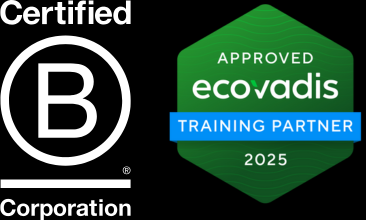The EU’s “stop-the-clock” Omnibus package has delayed CSRD/ESRS reporting, but companies still face uncertainty about the final requirements.
What Are the Main CSRD Omnibus Options for Companies?
The four main options are:
- Stopping all ESG activities
- Minimum activities (DMA, carbon footprint, data collection)
- Ongoing ESRS reporting
- VSME reporting
Each approach has unique benefits and risks, depending on company size and compliance priorities. Below, we explore each option in detail.
What is it?
Halting all environmental, social, and governance (ESG) data collection, reporting, and related sustainability initiatives.
Benefits:
- Immediate short-term cost savings.
- Frees up resources for other business priorities.
Risks:
- High risk of non-compliance if the Omnibus legislation is not approved, or if it passes with fewer adjustments than expected.
- Potential for significant penalties under current CSRD transposition - up to 3% of company assets.
- Loss of ESG momentum and reputation, making future ramp-up more difficult.
- Falling behind competitors who continue sustainability efforts.
Considerations by company size:
- Large companies (1,000+ employees): Not recommended; most will remain in scope and under scrutiny.
- Mid-sized companies (250–1,000 employees): Risky unless clearly out of scope.
- Small companies (<250 employees): May be justified only if clearly exempt, but should monitor supply chain and customer expectations.
What is it?
Maintaining essential ESG activities such as double materiality assessment (DMA), carbon footprint calculations, and collecting sustainability data for business partners.
Benefits:
- Minimizes costs while keeping the company prepared for future reporting.
- Maintains critical data streams likely to be required under any scenario.
- Provides a foundation for rapid compliance if Omnibus requirements clarify.
Risks:
- Data collected may be insufficient if the final ESRS reporting requirements are broader.
- Risk of scrambling to fill data gaps if the Omnibus is not approved or is significantly altered.
- Some risk of non-compliance or reputational damage if expectations shift quickly.
Considerations by company size:
- Large companies: A pragmatic fallback, but should be paired with close regulatory monitoring.
- Mid-sized companies: Sensible hedge against both inclusion and exemption.
- Small companies: Cost-effective way to stay engaged, especially if serving large clients requesting ESG data.
What is it?
Continuing full ESRS reporting activities, with a focus on strategic topics most relevant to the business and stakeholders.
Benefits:
- Safest option for compliance, ensuring full readiness for audit and regulatory review.
- Maximizes the utility of collected data for both compliance and internal strategy.
- Demonstrates sustainability leadership to investors, customers, and employees.
Risks:
- Potential for sunk costs if some reporting activities become unnecessary under a revised Omnibus.
- Resource-intensive; may divert attention from other priorities.
- Some activities may exceed future requirements, but most data and process improvements retain business value.
Considerations by company size:
- Large companies: Strongly recommended; most likely to remain in scope.
- Mid-sized companies: Justified for those aiming to maintain a leading ESG profile.
- Small companies: Likely excessive unless driven by specific stakeholder or market demands.
What is it?
Adopting the Voluntary SME (VSME) reporting standard, designed for companies likely to be exempt under new thresholds.
Benefits:
- Streamlined, proportionate reporting for companies under 1,000 employees.
- Ensures compatibility with ESRS requirements for business partners and large customers.
- Maintains ESG engagement with lower administrative burden.
Risks:
- VSME lacks some elements of full ESRS, creating compliance gaps if the Omnibus is not approved or is amended.
- Second riskiest approach after stopping all ESG activity.
- May need to supplement with additional data collection (e.g., DMA) for future compliance.
Considerations by company size:
- Large companies: Not suitable; should focus on full ESRS.
- Mid-sized companies: Attractive if likely to fall out of scope, but should monitor for changes and consider additional data collection and DMA.
- Small companies: Practical and proportionate, especially for maintaining supply chain relationships or preparing for future voluntary disclosures.
Recommended Course of Action by Company Size
Large Companies (1,000+ employees):
Continue with full ESRS reporting and compliance preparations. Use the delay to refine data quality, strengthen internal processes, and align with global standards. This minimizes compliance risk and positions the company as a sustainability leader.
Mid-Sized Companies (250–1,000 employees):
Adopt a hybrid approach: Maintain minimum activities (DMA, carbon footprint, key data collection) and voluntary reporting on the most strategic material topics. Consider voluntary VSME reporting if likely to be exempted. Monitor legislative developments closely and be ready to scale up if needed.
Small Companies (<250 employees):
VSME reporting or minimum activities are likely sufficient, unless driven by specific customer or investor demands. Stay informed about regulatory changes and supply chain requirements, but avoid over-investing in full ESRS unless necessary.
Choosing the Right CSRD Omnibus Option
The CSRD/ESRS landscape is evolving, and the Omnibus delay offers both relief and uncertainty. By carefully evaluating the four main CSRD Omnibus options—stopping all ESG activities, maintaining minimum activities, ongoing ESRS reporting, or adopting VSME standards—companies can balance cost, compliance risk, and long-term sustainability value.
The best strategy is to remain agile, monitor regulatory developments, and use this period to build ESG capacity that positions your business for future compliance and leadership in sustainable reporting.


